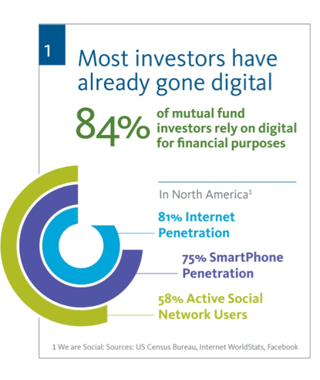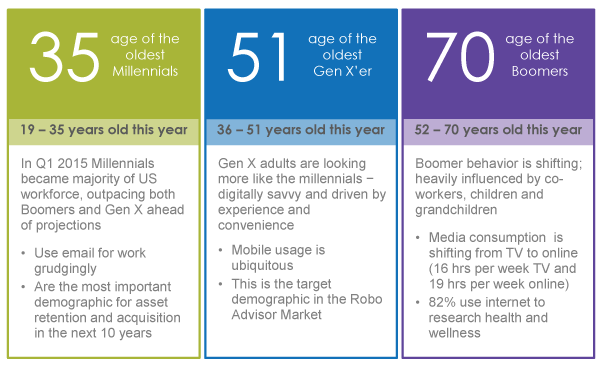Our industry is lucky to operate during a time in which digital technology, such as e-signatures, electronic forms and straight-through processing, is affordable, accessible and intuitive. Statistics show that 95% of investors with incomes of $75,000 or more have already gone digital. However, the insurance industry has been slow to the party with historically low single-digit eConsent adoption rates (partly because advisors own the email address, whereas carriers have the fiduciary obligation to deliver compliance content).
I recently spoke about consumer trends and the digital transformation of the industry at the Insured Retirement Institute’s 2016 IRI Ops/Tech Conference, where SIGNiX also presented about e-signature automation. As businesses continue to rely more heavily on tech, firms and advisors will be increasingly required to navigate a digital roadmap for their practices. And with this industry transition in progress, it’s wise to take note of the following digital truths:
- Digital momentum is unmistakable. As 87% of U.S. adults use the Internet, most investors have already gone digital in one way or
 another. In fact, 84% of mutual fund investors rely on digital for financial purposes. What’s more, 81% of investors are using the Internet, 75% use a smart phone, and 58% are active on social media.
another. In fact, 84% of mutual fund investors rely on digital for financial purposes. What’s more, 81% of investors are using the Internet, 75% use a smart phone, and 58% are active on social media.
- Digital drives cost savings. Technology will always be a capital investment, but its return is typically achieved in a matter of weeks or months, making it a significant driver of cost savings. For example, traditional offset-print tri-annual mailings can cost $25-$30 per account holder, whereas sending an email with links to the EDGAR-sourced document is under a dollar per customer mailing.
- Digital makes customers happier. Our society places a high value on instantaneous access to information—whether it’s inside our home, at work, or on-the-go. Mobile and cloud-based technology allows insurance information to transcend geographic location and gives customers access to information in the manner most convenient for them. Digital also provides an integrated experience, with analytics and content personalized to the recipient and integrated research relevant to each customer’s unique circumstances.
- Digital spans generations. The fear that digital could isolate older clients is unfounded. Digital adoption spans generations—from Millennials, who have grown up with technology at their fingertips, to Gen X’ers, who are driven by digital’s convenience. Even the oldest of Baby Boomers are increasingly turning to the Internet for information, often driven by their Millennial children or grandchildren. Customer expectations have been shaped by the unprecedented ubiquity of tech companies like Google and Apple, which deliver information intuitively and seamlessly to the masses.
Firms looking to get started or to expand their digital presence will want to do so strategically. Take these steps to build a digital roadmap for your business:
- Start with small-scale technology implementations. Examine which small digital processes are likely to be most beneficial to your clients and test the waters.
- Effectively manage eConsents. Consents are essential to compliance, and you will need a software system or service provider that can a) support all types of consents and b) work within all types of operating systems.
- Consider moving beyond email. Email may be an effective form of digital communication for some clients, but more tech savvy clients may prefer information to be sent directly to a cloud-based platform (like DropBox or Google Drive) or signed electronically through cloud-based e-signature software.
- Find a trusted partner. Going digital is an ongoing commitment—keeping up with new mobile platforms, browser upgrades, emergent technology and changing customer preferences. If digital is not a core competency, find a trusted service provider with a proven track record to ensure your customers are digitally engaged with transparency and efficiency.
Corey Fiedler is a Senior Director of Product Management with  Broadridge Regulatory Data and Communications. She manages development of the Broadridge Consent Accelerator utility, in partnership with the industry’s leading broker-dealer firms, and oversees insurance regulatory data and communications products at Broadridge. Previously she was Vice President of Product Management at Thomson Reuters. Connect with Corey by visiting her LinkedIn page here.
Broadridge Regulatory Data and Communications. She manages development of the Broadridge Consent Accelerator utility, in partnership with the industry’s leading broker-dealer firms, and oversees insurance regulatory data and communications products at Broadridge. Previously she was Vice President of Product Management at Thomson Reuters. Connect with Corey by visiting her LinkedIn page here.
To learn more about the security of digital signatures, download this free eBook.
%20formatted-1.png?width=2528&height=739&name=SIGNiX%20Logo%20Main%20(white)%20formatted-1.png)


